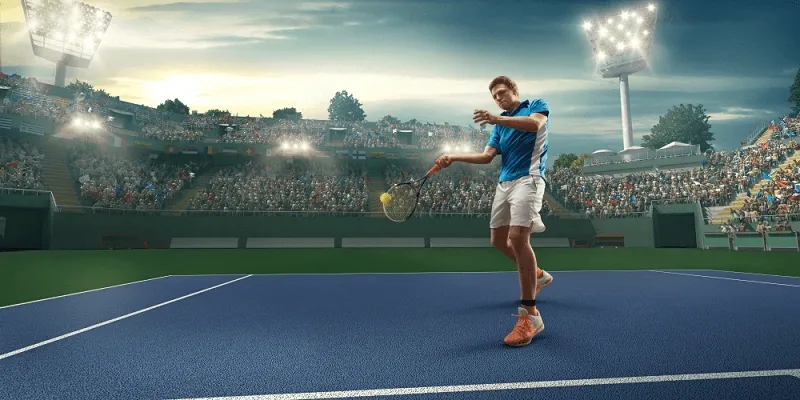Walkover in Tennis: What It Means & How It Impacts Betting

If a tennis player withdraws from a match because of illness or injury, either before it begins or partway through, it’s called a walkover. The other player wins automatically, and no ranking points are given.
For betting, this can change everything. When the walkover occurs before the first serve, most sportsbooks cancel the bets. If it happens during the match, it depends on the sportsbook — some may cancel the bet, others may pay out based on how far the match went.
What does walkover mean in tennis? Understanding how walkovers affect bets helps you avoid surprises and make smarter tennis wagers. Find out how to bet on tennis?
Understanding Walkovers in Tennis

A walkover in tennis means a player moves to the next round without playing the match. The opponent may withdraw before the match or simply not appear to play. This situation leaves the remaining player as the automatic winner.
What is a walkover in tennis? Tennis walkovers occur more frequently than many fans realize. Professional tournaments see dozens of these situations throughout the season. Players withdraw for various reasons - injuries sustained during practice, sudden illness, family emergencies, or travel complications that prevent them from reaching the venue on time.
The official tennis rulebook treats walkovers differently from retirements during play. A retirement happens when a match begins, but one player has to stop playing because of an injury or another reason. Walkovers happen before any tennis ball gets hit in anger.
Tournament organizers announce walkovers as early as possible to inform spectators and adjust the schedule. Whats a walkover in tennis competitions? Major tournaments like Wimbledon or the US Open typically make these announcements several hours before the scheduled match time. Smaller tournaments might announce walkovers just minutes before play was supposed to begin.
Common reasons for tennis walkovers include:
- Injuries that prevent safe participation
- Sudden illness affecting performance capability
- Personal or family emergencies requiring immediate attention
- Transportation delays preventing timely arrival
- Visa or travel document issues for international players
- Equipment problems that cannot be resolved quickly
The player who receives a walkover tennis gets full ranking points for that round victory. Their opponent receives no points and must pay any applicable fines for withdrawing without proper medical documentation. ATP and WTA tours have specific rules about when players can withdraw without financial penalties.
Most beginners learn early what is walkover in tennis. Spectators holding tickets for matches that end in walkovers typically receive refunds or can exchange their tickets for other matches during the tournament. Some venues offer partial refunds since fans miss the anticipated entertainment value of the match.
Walkovers create ripple effects throughout tournament draws. The advancing player gets extra rest time before their next match, which can be advantageous or disadvantageous depending on their current form and rhythm. Some players prefer staying match-sharp through regular competition, while others benefit from the additional recovery time.
Statistical records count tennis walkover victories the same as regular match wins. These results appear in head-to-head records between players, though many tennis databases note the walkover designation to distinguish from contested matches.
Different Types of Walkovers in Tennis
Tennis competitions encounter various withdrawal scenarios that result in automatic advancement for one player. Tournament officials must navigate these situations according to established guidelines while considering the unique circumstances of each case.
Several forms of tennis walkover meaning are acknowledged in the pro game:
- Players choose to step away from competition due to physical ailments or health concerns. Sometimes personal tragedies or family emergencies force athletes to abandon their tournament participation entirely.
- Rule violations or disciplinary issues lead officials to ban certain competitors from continuing, creating forced withdrawals that remove players against their wishes.
- Athletes who miss their scheduled court time without any advance warning automatically forfeit their position in the draw.
- Tardiness beyond acceptable limits results in disqualification, as tournaments maintain strict punctuality requirements for all participants.
- Medical professionals occasionally prohibit competition when they identify serious health risks that could endanger player safety.
Walkover meaning tennis wise is simple: no match, automatic win for one player. These different scenarios require careful documentation by tournament staff. Officials must verify the legitimacy of each withdrawal while ensuring consistent rule application across all events. The classification process helps keep players safe. It also makes sure the competition stays fair in pro tennis.
The Origin and Meaning of the Term ‘Walkover’

What does a walkover mean in tennis? "Walkover" comes from horse racing customs dating back to the 1800s. When only one horse appeared for a race, that animal still had to complete the course by walking or cantering to claim victory officially. This simple journey across the finish line gave birth to the expression we use today.
Tennis adopted this terminology during its early development as an organized sport. The concept perfectly captured situations where one competitor advances without facing opposition. Just like those solitary horses, tennis players receiving walkovers still "walk over" to the next round, though no physical walking occurs on court. So, now you know what's a walkover in tennis.
Other sports gradually embraced the same language. Boxing, wrestling, and various team competitions all use "walkover" to describe uncontested victories. The term became universal sporting vocabulary by the early 20th century.
Modern tennis maintains this historical connection through official rulebooks and tournament documentation. Match records still list "W.O." as the standard abbreviation for walkover results. Professional commentators and sports journalists continue using the original terminology when describing these automatic advances.
The phrase demonstrates how sporting language evolves from practical origins into lasting tradition. Horse racing's simple solution to empty starting gates created terminology that remains relevant across numerous athletic disciplines today.
Walkover vs. Retirement, Withdrawal, and Default – Key Differences
Tennis terminology often confuses fans because several situations result in matches ending without completion. Each scenario follows distinct rules and carries different consequences for players and their tournament standings. Understanding the walkover in tennis meaning helps make sense of sudden withdrawals on matchday.
Retirement in Tennis
Retirement occurs when a match begins but one player cannot continue due to injury or illness. The player who retires is counted as the loser, and their opponent moves on. Key characteristics include:
- Match must have started officially
- Player exits during active play
- Opponent receives full victory credit
- Retiring player keeps any points earned before stopping
Retirements happen frequently during long tournaments when physical demands accumulate. Players often retire to prevent serious injury that could sideline them for weeks or months.
Withdrawal from a Tournament
Tournament withdrawal happens before any match begins, removing a player from the entire event. This differs from single-match walkovers because it affects multiple rounds. Common withdrawal scenarios:
- Pre-tournament injury diagnosis
- Visa or travel complications
- Personal emergencies requiring immediate departure
- Late entry into higher-priority events
Withdrawn players receive no ranking points and may face fines depending on timing. Their scheduled opponents automatically advance until replacement players fill vacant draw positions. Understanding what is a walkover helps explain sudden changes in brackets or match schedules.
Default and Its Implications
Defaults represent the most serious consequence in tennis, removing players for misconduct or rule violations. Unlike voluntary withdrawals, defaults carry additional penalties including:
- Immediate point and prize money forfeiture
- Potential tournament bans
- Disciplinary review by governing bodies
- Mandatory counseling programs for severe cases
Officials can default players for verbal abuse, equipment destruction, or unsportsmanlike conduct toward opponents, officials, or spectators. In simple terms, what is a tennis walkover means a match that never happens due to withdrawal.
How Walkovers Impact Tennis Betting

Walkovers create unique situations for tennis bettors that require understanding specific sportsbook policies. In official rules, the walkover tennis meaning covers cases like injuries, illness, or no-shows. Different tennis betting platforms handle these scenarios in varying ways, making it essential to know the rules before placing wagers.
Most sportsbooks void all bets when walkovers occur before matches begin. Bettors receive their stake money back regardless of which player they supported. This protects customers from losing money on events that never materialized into actual competition.
Some betting markets remain valid despite walkovers:
- Tournament winner bets typically stand since the advancing player still progresses
- Head-to-head season records may count walkover victories
- Certain prop bets about reaching specific rounds stay active
Pre-match walkovers announced hours before scheduled start times usually result in complete bet cancellation. However, last-minute withdrawals might follow different rules depending on individual sportsbook policies.
Smart bettors review terms and conditions carefully, especially for major tournaments where walkovers happen more frequently. Understanding how different platforms handle these situations prevents confusion when unusual circumstances arise.
Live betting markets close immediately when walkovers occur, preventing any new wagers on the affected match. Existing live bets typically get voided, though some operators maintain different policies for various bet types.
Famous Walkover Incidents in Tennis History
Several high-profile walkover situations have left permanent marks on tennis culture. These moments reveal how quickly circumstances can change the course of major tournaments and reshape competitive narratives.
ATP Finals 2014 Walkover
The year-end championships saw drama when Kei Nishikori couldn't take the court against Roger Federer. A wrist injury made the Japanese star drop out. So Federer moved to the next round without playing.
The situation affected multiple aspects:
- Automatic semifinal qualification for the Swiss maestro
- Schedule reshuffling by event organizers
- Altered group stage mathematics for remaining players
- Disappointed spectators seeking ticket remedies
Nishikori's missing action pointed to the exhausting pace of professional tennis. Even reaching the season's pinnacle event doesn't guarantee players can compete at full capacity after months of intense competition.
French Open 2021 Walkover
There was big controversy at Roland Garros when Naomi Osaka decided to leave during the event. The four-time Grand Slam champion cited mental health struggles as her primary reason for departure, igniting global conversations about athlete wellbeing.
Her exit transformed both the tournament landscape and broader sporting discussions. The walkover became a catalyst for examining how professional tennis addresses psychological pressures facing elite competitors.
Wimbledon 2024 Walkover
Novak Djokovic found himself advancing through the All England Club draw without playing when his fourth-round adversary pulled out. Physical concerns prevented the match from occurring, granting the Serbian automatic progression while leaving ticket holders without their anticipated entertainment.
Officials managed the disruption smoothly, providing alternative viewing options and preserving the tournament's overall timeline despite the unexpected development.
Final Thoughts on Tennis Walkovers
Tennis walkovers represent an inevitable part of competitive sport that fans and bettors must understand. These situations highlight the unpredictable nature of professional athletics, where circumstances beyond anyone's control can instantly change tournament dynamics.
Players receiving walkovers face both advantages and challenges. Extra rest can help recovery, but maintaining competitive rhythm becomes difficult without regular match play. The psychological impact varies among athletes - some appreciate the break while others prefer staying sharp through consistent competition.
For spectators and bettors, walkovers create disappointment but also learning opportunities. Understanding how different scenarios affect tournaments, betting markets, and player progression helps navigate these unexpected moments more effectively.
Modern tennis continues evolving its approach to player welfare, recognizing that forcing competition through injury or personal crisis serves nobody's interests. The sport increasingly prioritizes long-term athlete health over short-term entertainment value.
Walkovers will always exist in tennis. Accepting their role while understanding their implications makes for more informed fans and smarter betting decisions across all levels of professional competition.
FAQ
Most sportsbooks void all bets and return your stake money when walkovers occur before matches begin. Tournament winner and outright bets usually remain active since the advancing player still progresses.
Predicting walkovers is extremely difficult since they typically result from sudden injuries, illness, or unexpected personal circumstances. Monitoring player fitness reports and practice sessions provides minimal insight into potential withdrawals.
Betting platforms vary in their walkover policies. Some void all markets immediately, while others maintain certain bet types like tournament winners. Always check specific terms and conditions before placing tennis wagers.
Walkovers occur when a player withdraws or fails to show up before the match gets underway. Forfeits occur during active play when players quit or get disqualified for misconduct. Both result in automatic advancement for opponents.

Sergey Ilyin
An experienced specialist in the field of betting and gambling. He analyzes market trends, player behavior, and the dynamics of online gaming platform development. An expert in the intricacies of sports betting and knowledgeable about the regulatory framework of the gambling industry.
